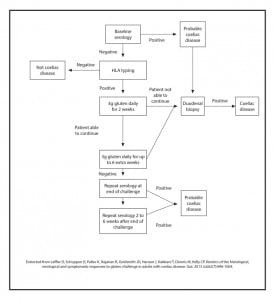 One of the questions that crops up in the clinical management of patients suspected of having coeliac disease, is: If my patient has been gluten free, or is going to try an exclusion from gluten containing foods, how long should they be free of gluten before undertaking a gluten challenge test?An article in GUT looks to explain this in some detail [1]
One of the questions that crops up in the clinical management of patients suspected of having coeliac disease, is: If my patient has been gluten free, or is going to try an exclusion from gluten containing foods, how long should they be free of gluten before undertaking a gluten challenge test?An article in GUT looks to explain this in some detail [1]
Our understanding of the pathophysiology of coeliac disease has advanced with associated improvement in diagnostic modalities. Recent studies have placed the prevalence of coeliac disease in Western populations at between 1:250 and 1:67. Coeliac disease is common throughout the world and most cases go undiagnosed. Understanding the risk factors, clinical presentations and diagnostic modalities is necessary to identify and treat patients with this commonly misdiagnosed disorder.
Abstract:
Objective
Coeliac disease is defined by gluten responsiveness, yet there are few data on gluten challenge (GC) in adults on a gluten-free diet. Lack of data regarding the kinetics of responses to gluten is a limitation in clinical practice and research when GC is performed.
Design
20 adults with biopsy-proven coeliac disease participated. The study included two run-in visits followed by a 14-day GC at a randomly assigned dose of 3 or 7.5 g of gluten/day. Study visits occurred 3, 7, 14 and 28 days after starting GC.
Duodenal biopsy was performed during the run-in and at days 3 and 14 of GC. Villous height to crypt depth ratio (Vh:Cd) and intraepithelial lymphocyte (IEL) count/100 enterocytes were measured by two pathologists. Antibodies to tissue transglutaminase and deamidated gliadin peptides, lactulose to mannitol ratio (LAMA) and symptoms were assessed at each visit.
Results
Significant reduction in Vh:Cd (2.2–1.1, p<0.001) and increase in IELs (32.6–51.8, p<0.001) were seen from baseline to day 14. Antibody titres increased slightly from baseline to day 14 of GC but markedly by day 28. LAMA did not change significantly. Gastrointestinal symptoms increased significantly by day 3 and returned to baseline by day 28. No differences were seen between the two gluten doses.
Conclusions
14 day GC at ≥3 g of gluten/day induces histological and serological changes in the majority of adults with coeliac disease. These data permit accurate design of clinical trials and indicate that many individuals will meet coeliac diagnostic criteria after a 2-week GC.

Reference
[1] Leffler D, Schuppan D, Pallav K, Najarian R, Goldsmith JD, Hansen J, Kabbani T, Dennis M, Kelly CP. Kinetics of the histological, serological and symptomatic responses to gluten challenge in adults with coeliac disease. Gut. 2013 Jul;62(7):996-1004. View Abstract






2 Comments. Leave new
This concludes that “many individuals will meet coeliac diagnostic criteria after a 2 week GC”. Can you please clarify exactly what percentage of people will meet this criteria? How many already confirmed coeliac patients will not meet this criteria after the two week period, and therefore be a false negative? How did the percentage of accurate diagnoses increase at the 4 week mark?
Thanks,
Shelly
Hello Shelly.
Thank you for the enquiry. It appears from this published study that people who are suspected of coeliac (as opposed to non coeliac gluten sensitivity) will demonstrate pathological changes after a 3gm challenge for 2 week of gluten. The paper is unable to determine how many would not with any statistical certainty, but recognises that as in virtually all clinical challenges some will not respond in a consistent manner.
The simplistic conclusion is that to be sure that diagnosis is given a fair chance this is the dose required, and many people are unsure how long one should eat gluten after a period of exclusion or how much, this paper is starting to clarify those parameters.